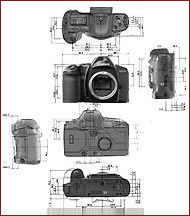The smooth, curved organic shapes of the many Canon EOS-1 series bodies can be regarded as one of the many factors contributed to Canon successful wide acceptance. Stylish, modern yet making you feel confidence and convinced in the mind that it is a high quality precision imaging tool and will never fail you in its reliability. Actually, when you think deeper, there was a lot of wisdom in applying common sense by adopting this form of the EOS-1 series design; and even from its exterior appearance, its sheer look can be very inviting to even a potentially new user. I am not sure who was the designer for the original EOS-1 back in 1989 but those who has been keeping track of development history fro SLR camera design would probably agree, the early '80 staged an era where traditional oriental creativity in camera design reached a plateau of limitation. That was where Japanese manufacturers began turning to the West in inviting creative minds to instill a little refreshing ideas. The first in making such a move on a mass production camera model was Nikon with their Nikon F3 - where an Italian industrial designer (Giorgetto Giugiaro of Giugiaro Design, Italy.) was called in to provide some inspirational idea to help them creating a new body design so as to bridge users in accepting the changeover between mechanical/electronic in their flagship camera model, and as everyone knows by now, that was where the distinctive Nikon redlined strip on their subsequent camera bodies was first used.
 |
|
 |
In 1986, after initial success of a new wave Canon T-series models, Canon has decided to invite a German industrial designer, Luigi Colan (website or Canon Japan's profile) to give try on the Canon T90 early design project - the resulting camera was easily one of the most elegant looked modern SLR camera - similarly, it was also arguably, in terms of features and trend leading concept - one of the best designed manual focus SLR camera model ever. I cannot read or find any relation pertaining to any involvement of Mr. Luigi Colan with the EOS project in his home page (except for T90 and the futuristic Photura EPOCA). But the T90 project could has cast a big influence to design team of the Japanese electronic giant from then on. In fact, many in-house talent were beginning to surface from here (for an example, Mr. PhoNoboru Tanaka who was part of the design team for the later Canon EOS-1V project, other involvement of him in designing such as equally elegant looking Canon EOS10QD and the immensely popular Canon EOS 55 (Elan IIE in North America market) etc.). That was indeed a good move back in the 1986 after all, huh ? |
Well, since Canon made no mentioning on the actual designer for the EOS-1(x). I will skip this unanswered "??" here. When the Canon EOS-1 was introduced back in 1989, early reviews suggested a mixed of opinion with the change of form because even after the debut of the few EOS-6xx models prior to the model, some were still unaccustomed to see only LCD and simple buttons to be used on a professional class SLR camera (well, primarily one tends to use a comparing Nikon F4's traditional maneuver of levers & buttons in making comparison). But those are history now. Generally, most would agree the EOS-1's simplicity present better logic than the conventional. Well, call it an acceptance of facts or whatever, I do agree professional-grade SLR cameras should be designed as simple as it can - without cluster of control buttons or levers around the entire body - as the more it has, chances overlooked mistakes on accidental activation are higher; personally, I grew to like the simplicity presented in the EOS-1N more.
 |
As I said earlier, the daring business decision for Canon in decisively abandoning the old FD-mount, switching to adoption of the untested EOS/EF system also indirectly reflects the Company culture. It has taken Canon followers a few years to well digest the hurt feeling and faced another decision whether to invest into the EOS system from scratch. There was no hidden fact that a small portion of the photographers also migrated to other system such as Nikon or to a less extend, the Minolta. But majority were staying and accepted the fact. A few factors, primarily and most important, Canon did a fantastic work in helping (not just passive marketing) the FD-based professionals in evaluating the superior advantages of the EOS system bring over previous FD-mount system. |
 |
The prelude introduction of Canon EOS system with bodies such as EOS-650 can be considered quite fragile in their respective technical specification to meet professional expectation but a much better-spec Canon EOS 620 did a reasonably well supportive role as an illustration model in demonstrating operational strength of the EOS system along with a series of high performance, whisper quiet, EF autofocus lenses previously deemed impossible to be realized (for an example, EF 50mm f/1.0L ). Next, the few years of patience intensive promotion also did the trick, as nest system upgrading for FD-mount users may face the same scenario, which left choices narrowed down to Nikon & Canon again - So, you can say the debut of the Canon EOS-1 couldn't be more timely. Even if the pre-EOS-1 camera bodies like (EOS-models (EOS-650 (1987.2) | EOS-620 (1987.5) | EOS-750QD (1988.10) | EOS-850QD (1988.10) | EOS-630QD (1989.4) may not have been measured to demanding expectation of professionals but features of these midrange EOS models embodied such as quick, fast & quite USM AF operation, LCD readouts, push button control etc.) did their respective role in laying a foundation for the fast acceptance of the coming pro-grade Canon EOS-1 later in 1989 - this was where Canon has successfully transforming the defensive minds into anticipation of a professional model. |
The original Canon EOS-1 was without weaknesses on its own (something a Nikon fan can easily picked up such as .."oh yeah..., plastic body, shutter measures 1/3 of a comparing Nikon F4 in guaranteed exposure cycles, no interchangeable finders, no backward compatibility, no freeze-focus, mirror can't lock up etc...".. But the Canon EOS-1 has something that action orientated professional photographers wanted or Nikon missed - FAST and QUIET autofocusing with option personalize the camera via custom settings. The backbone of the EOS-1 was the EF lenses - an area Canon truly excelled in bringing the numbers quickly while on the other hand, Nikon has strangely reacted slowly (VERY slow..). I think "slow" because they have no solution in finding a way to improve the AF architecture due to camera drive AF. So, the interim measure Nikon used was via an AF-teleconveter TC-16 which converts manual focus Nikkor lenses into an AF lense (compromised by extending the primary focal length by 1.6x). Neither development of AF-Nikkor was decisive & fast enough to cope with changes in and around the market place. Although the first few years after its debut, the Nikon F4 sold very well in numbers due to these changes in the market. But as soon as the EOS-1 was made available, the overall performance of EOS/EF combination has truly made the Nikon 35mm AF photographic system looked a little pale in comparison - in particularly, choice on lens type, varieties and lens speed selection on the AF-Nikkor lense family was seemingly stalled in development. Frankly, Canon should also thank some of the strange decision-making fella at Nikon (hehe..), because if Nikon has ever thought seriously in adopting and improve upon their 1983's Nikon F3 AF principle, things can be quite different (at least, it may take longer time for Canon). But I have to admire all those Canon folks that involved around the EOS project those days as sometimes, there are things in life that even when you are equipped with strong financial muscle but may / could not be able to have achieved anything; in this case, with only strong framework of the EOS while riding on momentarily weakness of a respected opponent, it takes brain & guts in executing schemed strategies timely and decisively as well.
|
Whatever it is - instead of relating the Canon EOS-1N as a new camera model all together, I would rather categorized it as an worthy upgrade from the previous model. I think Canon has also interpreted correctly by naming it as EOS-1N where the "N" signifies "New" because while retaining the basic body chassis in order to ensure smooth migration for any previous EOS-1 owners, it also has been designed cleverly to patch weaknesses of the predecessor; while at the same time, directly aimed at the weak points of its main rivalry, Nikon F4 around important areas where professionals usually put their priorities on.
 |
The immensely success of the new model has catapulted Canon comfortably on the commanding driver seat from then on. Partly, the success story was also due to Nikon 's failure in responding positively from the pressure Canon thrown. Needless to say, naturally, smart photographers began switching camps (early Nikon news/sport professional users' groups such as USA Today, Washington Post, US All Sports, UK etc.). So, the period began from 1990, the commanding foothold Canon established with this gamble paid off. They finally have realized a dream they had cherished for the last 20 years in completing a business objective -recognized as the world's most successful camera manufacturer in every market segments, beside being the largest. |
Thus, when we go back to our discussion, one can digest easier with what has happened and why each feature we discussed later made such significance. Overall, the curved, smooth, streamlined body lines and layout of the new EOS-1N has not been changing too much from the its original design concept deployed in the EOS-1. So, design of both models were an evolution on the professional AF-SLR, developed to meet demanding professional's needs, by increasing and constantly improving. the features of the EOS-1, which has once revolutionized the professional market. Basically, Canon aimed by introducing a "Professional Camera System" complemented by largest EF lense lineup and an array of system accessories, to beat the Nikon's F4 System. With its harmonious coexistence of manual operations and automation under the EOS system concept of "Automation According to user's will". Designers of the upgrade model were thoughtful enough to consider some important design elements in deciding what to add-on or omit. The resulting camera ended with slight cosmetic changes to the exterior but retaining the core design of a few simple control buttons & switches for activation/operation. Don't get fooled by its straight forwardness - stealth within the simplicity, it is capable of delivering an astonishing wealth of features to meet any demanding task for advance imaging control.
So, basically, it retains the original concept from the earlier EOS-1 in ease of operation and even the basic layout and operation are almost the same - this is important because other than targeting new Canon owners, it also permits smooth migration of earlier EOS system owners. The uniquely Canon's Main Dial and Quick Control Dial are well positioned for fingers and simple to operate. So, you can say the adoption of the external design carries an objective outlined above where retaining an appearance of quality feel & look of a "professional's tool", while maintaining the basic image of the previous EOS-1. But there are some minor differences in the EOS-1N upgrade:
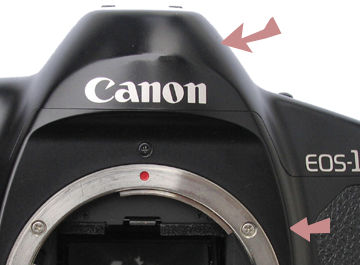 |
1). Maintaining a sloping-shoulder shape. |
 |
|
 |
(2) Adding carefully thought out improvements to operational features of the original EOS-1 The external color and finish is composed of black polyester-urethane coating as the undercoating and clear acrylic urethane coating as the top finish plus repeated baking processes (coating twice and baking twice), resulting in a deep black semi-glossy finish. Also, similar to the original EOS-1, synthetic leather lamination is employed to enhance richness and fullness as a well-crafted tool. (The color and finish of the earlier EOS-1 is semi-glossy black using black-finish chrome plating and top coating.) |
|
Visual differences in appearance between the Canon EOS-1N (1994) and the original Canon EOS-1 (1989):-
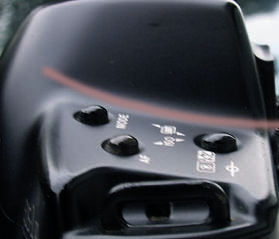 |
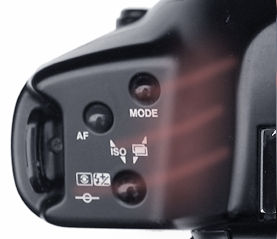 |
The profile of the enlarged pentaprism section and that connecting the upper cover and apron have become steeper, resulting in an even more sophisticated overall appearance. The balance between the enlarged pentaprism section and the left and right shoulders has been reviewed to adopt a somewhat steeper slope appearance at the mode button section. |
But more importantly, the change of a larger pentaprism section was essential due to the incorporation of the superimposed display unit, and the lines extending from the top cover to the base of the front cover are sharper, which indirectly resulting in a more refined form. And because to such reevaluation of the balance between the larger pentaprism section and the left and right shoulders, the surface area surrounding the mode buttons has more of a slant than the earlier Canon EOS 1.
 |
Due to tendency or frequent auto exposure control during shooting, Canon acknowledges convenience of fine tuning exposure was important. So, an exposure compensation button has been added beside the LCD panel illumination button. Strangely, the swift switching of mode drive selection was not added here. But as partly the addition of this button could be concluded based on numerous feedback from working photographers and the omission was also partly due to that. Anyway, seemed like not too many people are complaining, so, it should be fine. At the rear section, I think the decision of an eyepiece shutter inclusion (see below) was more significant as most often, the position of the ambient meter cells inside the pentaprism was too close for comfort being affected when leaving camera unattended during self timer/unmanned remote photography and/or shooting with camera tilting upwards with possible entry of strong light source at rear section to affect its meter accuracy |
 |
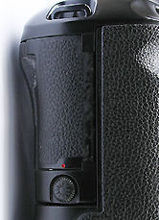 |
Left: -The palm wing surface is provided with leather pattern molding plus rubber coating to improve holding comfort as well improve wear * tear resistant sue to foreseeable frequent use of the Custom function & drive mode etc. residing inside. |
Lastly, the color of the exterior appears to be different from the EOS-1, where as compared to the EOS-1, the black external finish of the EOS-1N has a slightly deeper luster. This was purely a cosmetic changes, providing a more refined, quality image of the hardware. On an even more minor note, some indications have been changed to pictorial symbol for easier-to-understand, quicker recognition and wider appeal to new users of Canon EOS system.
Well, the model name, "EOS-1N" was also there to provide the most easy visual differentiation among all the respective external identifications between the two old/new models. Anyway, much of far superior features, functions as well as performance benchmark of the EOS-1N are actually embodied within the seemingly identical physical dimension and we will go through from here sections by sections. But before that, please note The EOS-1N family consists of the following three models in addition to the standard model:
| Previous | Next -->>>Part II
Basic Design: - Part 1 | 2 | Basic Camera Features: - Part 1 | 2 | 3 | 4
| Questions, Issues
& Answers
| Canon
EOS-1 Series Message
Board
|
Canon
EF lens Board
| in
a shared environment
|
Free Trade Zone |
shared
environment
| Back | Index Page The Canon EOS-1N
Series Professional SLR camera
|
Back | Main Index Page The Canon EOS-1
Series Professional SLR camera
Background and Various
Issues | The Basic Features & various Setup
Manual &
Auto Focusing |
Metering Systems | Exposure Control | Viewfinder
Optical
System Flash Photography (with Speedlite 540EZ extension & Selective info on Canon TTL Flash Models:-160E | 200E
| 300EZ | 300TL
| 420EZ | 430 EZ | 480EG | MacroLites | Other non-TTL Canon flash model
Reliability Issues:- Body Chassis | Shutter Unit | Electronic Circuitry | Film Transport & film handling Secondary Functions:- Custom Function Part One | Part Two | System Accessories:- Film Back Options - instruction for Command Back E1 | Macro/Close Up Part one | Part two and Part III Flash for Macro-Photography | Power Sources -BP-E1 | PDB-E1 | Focusing Screens | Remote Control with Wireless Remote Set LC-3 | System compatibility
Variants of Canon EOS-1N:- Canon EOS-1N RS | Canon/Kodak Digital DCS-1, 3 -5 & 520/560 Series | Full Technical Specification | Main
Reference Map / Nomenclature
| Resource Centre:- Comparative Charts between EOS-1 &
EOS-1N / or with
its active Competition(s) (Nikon); Quick Operational Reference Card (278k Gif File);
Listings of 7-segment
digital numbers/letters
appeared on LCD display panel/viewfinders (HTML page); External Link:-Instruction Manual (3.3MB
PDF file applicable for both Canon
EOS-1N (RS). | Using EOS system for your photography | Bots & Nuts of EOS System - by Philip Chong |
The Eyes of EOS -
EF Lenses
A little OFF-TOPIC SOME Personal Thought
HOME - Photography in Malaysia |
Volunteered Maintainer(s) for the Canon EOS-1N Series Message Board: Philip Chong, Editor, Digital Camera Magazine; Vincent Thian, Photo Editor, Malaysian Bureau, Associated Press "AP", CYleow, Ex-photo Editor of local daily, The Star; Gary Rowan Higgins, Australia and other nice folks on the web.
Special Credit:- :Mr. Richard Yeow & Mr. Simon Wong from camera division of ![]() Marketing Malaysia, for their continual effort in
supporting development of this EOS/EF website. Others: All the nice people on earth who have contributed
their photos and pictures of personal works or product shots for the creation of
this site. Certain content and images appeared in this site were either scanned
from official marketing leaflets, brochures published by Nikon and/or contribution
from surfers who claimed originality of their own work for public publishing in this
website, where majority of the extracted information are used basing on educational
merits. The creator of this site will not be responsible for any discrepancies that
may arise from any possible dispute except rectifying them after verification from
respective source. Neither Nikon or its associates has granted any permission(s)
in using their public information nor has any interest in the creation of this site.
"Canon", "EOS",
"EF" "RT", "EOS-1n RS", "Booster
", "Macrolite", "fluorite", "Image Stabilizer"
& other applicable technical/business terms are registered trade name(s) of Canon
Inc., Japan. Site made with an Apple G5 IMac.
Marketing Malaysia, for their continual effort in
supporting development of this EOS/EF website. Others: All the nice people on earth who have contributed
their photos and pictures of personal works or product shots for the creation of
this site. Certain content and images appeared in this site were either scanned
from official marketing leaflets, brochures published by Nikon and/or contribution
from surfers who claimed originality of their own work for public publishing in this
website, where majority of the extracted information are used basing on educational
merits. The creator of this site will not be responsible for any discrepancies that
may arise from any possible dispute except rectifying them after verification from
respective source. Neither Nikon or its associates has granted any permission(s)
in using their public information nor has any interest in the creation of this site.
"Canon", "EOS",
"EF" "RT", "EOS-1n RS", "Booster
", "Macrolite", "fluorite", "Image Stabilizer"
& other applicable technical/business terms are registered trade name(s) of Canon
Inc., Japan. Site made with an Apple G5 IMac.
